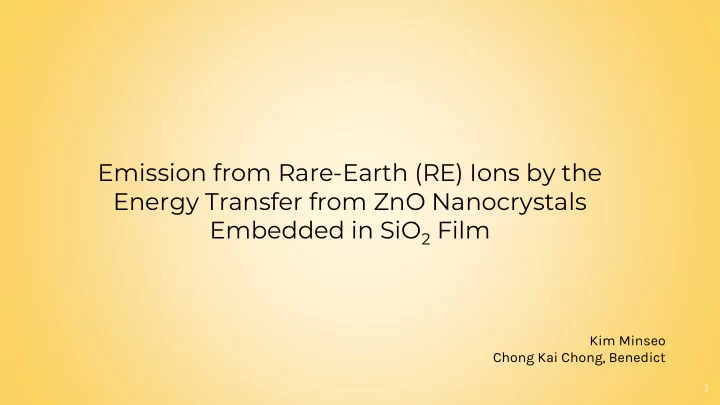

Emission from Rare-Earth (RE) Ions by the Energy Transfer from ZnO Nanocrystals Embedded in SiO 2 Film Kim Minseo Chong Kai Chong, Benedict 1
Table of Contents 1. Introduction 2. Research Aim 3. Methodology 4. Results and Discussion 5. Conclusion 2
Introduction 3
Introduction ● White-light LEDs ○ Mixing lights from various LEDs Using phosphor to convert light colours ○ 4
Introduction How is our research different from these semiconductors? 5
Introduction ● Zinc oxide Nanocrystals (ZnO-nc) commonly used as wide bandgap semiconductors ● Potential application in optoelectronics devices Efficient energy transfer from ZnO-nc to ● Rare-earth (RE) ions like Europium (III) ions (Eu 3+ ) and Terbium (III) ions (Tb 3+ ) 6
Introduction ● These samples are fabricated using cost- effective sol-gel process ● Relatively simple to fabricate samples Sol-Gel Process 7
Introduction Eu 3+ ions ⇒ Red ● Tb 3+ ions ⇒ Green ● ● ZnO-nc ⇒ Blue ● Potentially be used to create white light or various colours by differing concentrations of ions (RBG components will change) 8
Introduction Most research involve only one RE ion ● ● Simple photoluminescence (PL) measurements ○ Focus of paper was on efficiency of energy transfer instead Lack of research involving combination of two ● different RE ions ● Even fewer studies done on varying concentrations of RE ions to obtain different colours of light 9
Research Aim 10
Research Aim Prediction of concentration of RE ions for white ● light emission ● Cost-effective method of production and usage in display devices 11
Methodology 12
1931 CIE Diagram 13
Methodology X, Y and Z? Tristimulus values associated with the CIE 1931 XYZ ● color space Conceptualized as amounts of three primary colors in a ● tri-chromatic, additive color model 14
Results and Discussions 15
25 points for the combined emission from the two films each incorporated with either Eu 3+ or Tb 3+ . 16
18 points for the films with Eu 3+ and Tb 3+ incorporated together. 17
Graph of x against concentration of Eu 3+ and Tb 3+ ions 18
Graph of y against concentration of Eu 3+ and Tb 3+ ions 19
Graph of z against concentration of Eu 3+ and Tb 3+ ions 20
Polynomial equations relating concentrations of Eu 3+ and Tb 3+ to x, y and z 21
Results and Discussions White light emission for films with Eu 3+ and Tb 3+ ● incorporated together → 1.0% of Eu 3+ and 4.4% of Tb 3+ Combined white light emission from films with ● Eu 3+ and Tb 3+ incorporated separately → 7.3% of Eu 3+ and 9.3% of Tb 3+ 22
Results and Discussions Cost effective to incorporate Eu 3+ and Tb 3+ ● together as lower concentration of expensive RE ions needed Energy transfer from ZnO-nc to Eu 3+ ions is much ● more efficient than from ZnO-nc to Tb 3+ ions 23
Conclusion 24
Conclusion ● To improve reliability, we could have used other methods and cross reference the results Could have modelled the emission spectrum of ● each sample as a function of concentration of Eu 3+ and Tb 3+ ions ● Could have modelled X, Y and Z as a function of Eu 3+ and Tb 3+ ions instead of x, y and z 25
Conclusion ● Key exploration in obtaining desired emission spectrum from experiments and practical uses ● Has substantial potential in industrial light- emitting and optoelectronics devices 26
References 1. Pita, K.; Baudin, P.; Vu, Q.; Aad, R.; Couteau, C.; Lerondel, G. Annealing temperature and environment effects on zno nanocrystals embedded in sio2: A photoluminescence and tem study. Nanoscale Res. Lett. 2013, 8, 517. (Figure 1) 2. Mangalam, V.; Pita, K. Energy transfer from ZnO nanocrystals to Terbium (3+) ions: A spectral overlap study. n.d. 1-2 3. Mangalam, V.; Pita, K. Energy Transfer Efficiency from ZnO- Nanocrystals to Eu3+ Ions Embedded in SiO2 Film for Emission at 614 nm Nanoscale Res. Lett. 2017, 8, 1-9 4. Mangalam, V.; Pita, K.; Couteau, C. Study of energy transfer mechanism from zno nanocrystals to eu3+ ions. Nanoscale Res. Lett. 2016, 11, 1 – 9. 5. L. Luo et al. Strong luminescence and efficient energy transfer in Eu3+/Tb3+- codoped ZnO nanocrystals. Optical Materials, Volume 37, November 2014, Pages 470-475 https://doi.org/10.1016/j.optmat.2014.07. 008 27
Thank you! 28
MATLAB Loop Control Statements 29
30
Recommend
More recommend